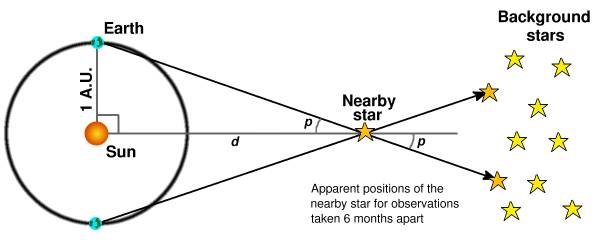How does the parallax effect work?
1 Answer
I'll keep this as simple as possible ... it's not easy to describe in words!
Explanation:
If you use only one eye to look at your extended hand and then swap eyes your hand appears to jump compared to the static wall behind it. This is because the line of sight has changed, because your two eyes are in different positions.
You can then test the effect further and hold one finger in front of your face at about 30 cm away (closer than your hand was) and you'll see that the 'jump' covers more of the background. It jumps more. This means we can use the extent of the 'jump' as a measure of distance from the object (hand/finger) to our eye.
We use this to measure the distance to stars in our galaxy because we see them against a very distant backdrop (assume other galaxies) and the point of view changes over 6 months as the Earth circles the Sun. A diagram is useful to clarify the idea ...

(Taken from a jpeg file at https://pbs.twimg.com/media/Ci6iK8zXEAAdKNM)
This works (very) well up to a point:

(Another jpeg, this time from http://www.ngawhetu.com/Resources/StellarDistance/images/ladderbar)
The Hipparcos satellite (see here: https://en.m.wikipedia.org/wiki/Hipparcos) has now used this effect to get an astonishingly precise distance measurement on almost 120 000 stars in our galaxy and the results proved so useful that a follow-up satellite, Gaia has now been in service since the early part of the century.
The principle has proved absolutely vital in establishing our distance scales across the universe because it is purely geometrical, relying on no assumptions about astrophysical or cosmological processes (which we often do not fully understand!)

